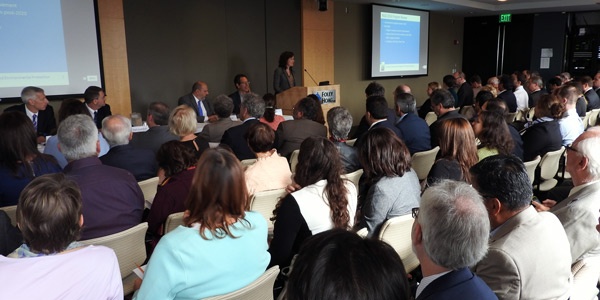By William Opalka
BOSTON — New England stakeholders are considering a future market design that could include a price on carbon and a two-tiered capacity market to accommodate state clean energy procurement.

Gordon © RTO Insider
Raab Associates’ 151st New England Electricity Restructuring Roundtable on Friday discussed the New England Power Pool’s effort to reimagine the market, dubbed Integrating Markets and Public Policy (IMAPP).
The initiative comes out of a recognition that the six New England states’ aggressive climate goals don’t align with competitive market structures, said NEPOOL Chairman Joel Gordon.
“The intent is to use the most efficient set of resources using the discipline of competition,” Gordon said. “If it’s successful, it’s going to fundamentally change how power markets work.” (See Q&A: NEPOOL Chair on Redesigning Market Rules for Low-Carbon Future.)
In a series of ongoing meetings, NEPOOL hopes to develop a framework document by the end of the year that could lead to further discussions in 2017 and eventual changes to the ISO-NE Tariff.
“A concern we have is the scale and scope of what [the states] are doing [with procuring carbon-free energy] that the scale is so large that there’s a fundamental risk to the markets that we have,” he added.
The first challenge is defining the policies — economic development, fuel independence and fuel diversity — and then deciding how much clean energy would be needed to achieve them, given the preferences of the individual states. Next comes market rules that promote the overall policy objectives. Finally, cost allocation among the various constituencies must be decided.

© RTO Insider
Gordon said 15 proposals have been made in the IMAPP process, which can generally be categorized in “three buckets.”
- A carbon adder would be technology-neutral and provide market signals to both supply and demand while also creating a revenue stream for the states.
- States’ long-term power purchase agreements for clean energy would support the development of new resources but also support existing generation. “It would be up to the states to decide what they want to procure,” Gordon said.
- A second tier to the capacity market would enable states to procure resources while protecting price formation in the Forward Capacity Market. “This is a mechanism that could help to incorporate those solicitations into the current market design without undermining the existing market,” Gordon said.

Robert Ethier, vice president of market operations for ISO-NE, said he could see a hybrid design eventually occurring.
“They’re not mutually exclusive. Conceptually, you could do all three, and some think that’s where we’ll end up,” he said.
Ethier said economists agree that a carbon price is the most efficient means to send market signals and achieve climate goals. “I’ve also been around long enough to know this is probably the least likely of the three to happen,” he added.
But there are other circumstances that will create challenges in the shorter term as the rules evolve.
Low energy prices, even during the recently concluded hot summer, were more than a function of cheap natural gas, he said. The addition of wind and behind-the-meter solar can depress energy prices, which has implications for the capacity market.
“What that means is the resources that we need when the wind isn’t blowing or sun isn’t shining are earning hardly anything to meet their capital costs, operating costs, so they’re just breaking even,” Ethier said. “So that puts more pressure on the capacity market to provide the revenue so they’re able to stay around when we need them.”

Dykes © RTO Insider
The capacity market is also pressured by renewable resources, which benefit from government subsidies like the federal production and investment tax credits, and state renewable portfolio standards, as well as long-term contracts through state-sponsored procurement.
But Katie Dykes, deputy commissioner at the Connecticut Department of Energy and Environmental Protection, said those state policies are needed to encourage clean energy development until market structures are in place.
“Is there a better mousetrap than the states doing procurements?” she asked. “In the near term we have to continue with it, but we’re very open and interested in other ways that we could come up with.”



